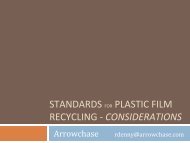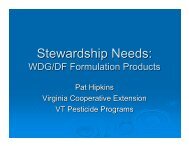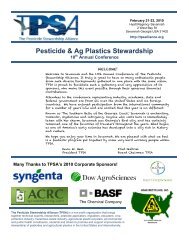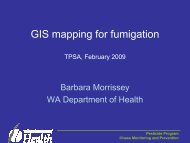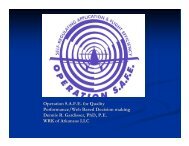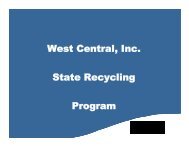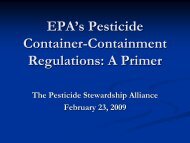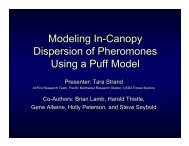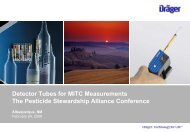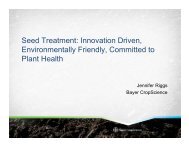Clean Sweep Programs - US Environmental Protection Agency
Clean Sweep Programs - US Environmental Protection Agency
Clean Sweep Programs - US Environmental Protection Agency
- No tags were found...
You also want an ePaper? Increase the reach of your titles
YUMPU automatically turns print PDFs into web optimized ePapers that Google loves.
Summary of Minnesota Waste Pesticide Disposal ProgramMinnesota originally held regional collection events, but found that the volume of pesticides collectedon a single day was very high and difficult to manage (15 tons or more). The revised collection planprovides a collection opportunity in every county at least once every other year. County officials workclosely with MDA staff on development, implementation and promotion of public awareness and participation.Each year, various locations (highway garages, chemical dealerships, etc.) are designated as one-daypesticide drop-off sites. Occasionally, on-site pesticide pickups are made to accommodate situations wherethe waste is too impractical or hazardous to move to drop-off sites safely. On-site collections are rarebecause they are expensive and time-consuming. The MDA signs all hazardous waste manifests andassumes waste generator status. The frequency of occurrence of some older products at drop-off sites isdecreasing. Minnesota accepts some dioxin-containing materials, and pesticides requiring an F code areaccepted only if the permitted disposal facility is operating.In 1997, MDA formed a partnership with several regional Household Hazardous Waste (HHW)programs to establish year-round pesticide drop-off locations. These sites accept pesticides from individualsor businesses that need timely disposal in an emergency situation. Collected pesticides are kept atstorage facilities until a hazardous waste contractor collects them.In 2000, Minnesota received a grant of $57,000 from EPA’s Region 5 to target collection ofpersistent, bioaccumulative toxins (PBT) during <strong>Clean</strong> <strong>Sweep</strong> programs. Minnesota had determined thatmore than 150,000 pounds, or about 10% of the total pesticides collected were PBTs including nearly 30tons of DDT. The grant was used to inform and alert participants who had not participated in previousevents, provide incentives (e.g., more collection sites, shorter travel distance), provide guidance on storage,and target PBTs during collection events. The 2000 collection included over 4,200 pounds of PBTs in atotal of over 123,000 pounds of unwanted pesticides.Future waste pesticide collections are of concern because of the decreasing amounts of wastecollected, which was already seen in 2000. The program has been successful in removing many of the largestores of waste pesticide. Practical collections with the reduced volumes will require re-evaluatingcontractor use and rethinking the scheduling of events. Adjustments over the next several years will addressthe reduced amount of stored waste and must still meet the needs of pesticide users looking for safe andproper disposal of waste pesticides.Minnesota has been collecting empty pesticide containers since 1990, when the results of a pilotproject prompted the state to expand it statewide. Each county has the opportunity to develop a collectionmethod that best meets the needs of their growers and agricultural chemical dealers. Some countiesdecided not to take an active role in pesticide container collection. State statute now requires sellers tocollect empty containers from their clients. If the county runs a countywide collection, the dealers arerelieved of that responsibility, but must still notify their clientele of the container recycling program. Thestatute served to bring together private industry and county agencies.



